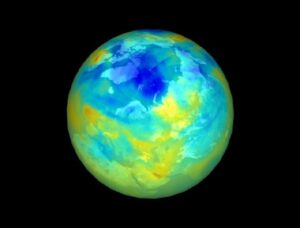The modified Molina-Rowland hypothesis (that CFC-related reactions, sped up by polar clouds, were leading to ozone losses) helped to inspire a flurry of experiments and atmospheric studies. These investigations produced several different lines of evidence, which turned out to support the updated hypothesis:
- Evidence that the proposed reactions actually happen on ice: Molina created a thin film of ice in a narrow glass tube and blew chlorine-containing chemicals into it. Sure enough, the proposed reactions ensued. Molina then went on to show that these reactions occur much more quickly than previously thought.
- Evidence that reactions on ice particles actually take place in the atmosphere: If the revised hypothesis were correct, scientists would expect that the abundances of chlorine monoxide and nitrogen dioxide (among other chemicals) would be affected by reactions on ice. Measurements of atmospheric chlorine monoxide revealed values about 100 times too large to be accounted for unless ice particles played an important role. Measurements of nitrogen dioxide provided similar evidence in support of reactions on ice particles.

- Evidence that increased ozone loss occurs whenever icy polar clouds are present: These clouds also form in the Arctic. If reactions on ice particles in these clouds really are to blame, then we’d expect to see ozone depletion in the Arctic as well — although less severe than in Antarctica, since the clouds are less common around the North Pole. Observations revealed exactly what the updated hypothesis predicted they would: a lesser degree of ozone depletion in the Arctic.

- Evidence that chlorine is causing the ozone depletion: According to the hypothesis, when CFCs break down they produce chlorine, which destroys ozone and generates chlorine monoxide. So scientists reasoned that if these reactions were occurring, ozone levels should be low where chlorine monoxide levels are high and vice versa. James Anderson was able to get this critical data by situating his measurement instrument on the wing of a plane flying through the Antarctic ozone hole.

Just as predicted by the Molina-Rowland hypothesis, ozone was low where chlorine monoxide was high, strengthening the link between chlorine and ozone depletion. As seen on the graph to the left, outside the hole (left side of graph), ozone levels are high and chlorine monoxide levels are low, while the reverse is true inside the hole (right side of graph). The evidence gathered from these and other investigations, collected by many different people over the course of a decade, ultimately supported the hypotheses that chlorine, predominately from CFCs, was the primary cause of the Antarctic ozone loss, that reactions on the ice particles of polar clouds accelerated this process, and that the same kind of chemical reactions were taking place in the Arctic.
Many different groups within the scientific community got involved with testing the hypothesis. For more information on the role of community in science see Science: A community enterprise.
